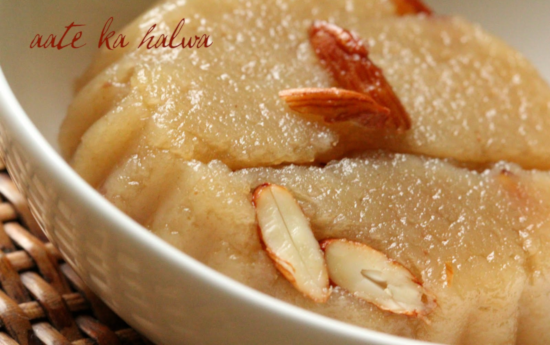Mama’s Punjabi Recipes: ATTE DA HALVA (Whole Wheat Flour Halva)
 Celebrations are a part of life and Punjabis mark each such occasion with some sweets, especially if it is an auspicious milestone, like a birthday, wedding, new job or any other piece of good luck. Below is a reprint of Mama’s Atte Da Halva recipe, which is a typical favorite sweet which can also double as a blessed offering to mark such occasions. It is reprinted with some additional information and directions.
Celebrations are a part of life and Punjabis mark each such occasion with some sweets, especially if it is an auspicious milestone, like a birthday, wedding, new job or any other piece of good luck. Below is a reprint of Mama’s Atte Da Halva recipe, which is a typical favorite sweet which can also double as a blessed offering to mark such occasions. It is reprinted with some additional information and directions.
For Punjabis, atta (whole wheat flour) is the carbohydrate of preference for most meals and many deserts, and rice is less of a staple dish. Hence, lots of dishes, including many sweets like pinnis, poodras and halva, are made of atta. It helps that whole wheat is preferred by dieticians for health reasons, even though excessive carbohydrates consumed are equally not healthy, and now many avoid it if they are on gluten-free diets.
Wheat flour halva is often served at religious functions and is always served at the temples after services. Although this sweet dish is considered mostly a Northern Indian confection, it is often associated with Punjabi cuisine. The same halva made with a slight difference can be used to make atta di pinniya (wheat flour sweetballs).
This is a fairly easy recipe and you can find the ingredients – atta, chinni (sugar), and pani (water) – easily in your home. You can add the amount of sugar to your choice, but I try to keep the halva not too sweet. Nowadays, I have heard that people even use sugar substitutes to prepare Indian deserts, but I prefer to use less refined sugar to bring out the authentic taste.
Another item that most Indians love are nuts, of any sorts, and Punjabis naturally gravitate to almonds, walnuts and raisins. Although halva by itself is delicious, it tatstes much better with some dried fruit added to it.
If you prefer, you can use brown sugar or gur (jaggery). Olive oil gives a better taste and is healthier than ghee (clarified butter). You can add more ghee if you like, but using less ghee makes browning the atta more difficult.
Ingredients:
½ cup of ghee (clarified butter) or olive oil
½ cup of atta (medium coarse wheat flour)
½ cup of chinni (sugar)
2 cups of pani (water)
Optional: ½ cup badam (almonds) or blanched, slivered almonds
Directions:
In a small saucepan, bring some water to a boil and then in the badam (almonds) for a few minutes. Drain the water and peel the almonds, then slice them and keep to the side.
Heat the ghee or olive oil in a kadai or wok over low heat.
Throw in the flour and brown it, stirring often, as you don’t want to have the flour get too brown as it may give a burnt smell. Don’t brown over high heat as the flour does not come out as tasty.
In a separate saucepan, boil the water and throw in the sugar, stirring till it is completely dissolved. Keep the mixture to the side for later use.
After the flour is slightly brown, pour the syrup into the kadai, stirring continually and turn the heat to medium.
When the ghee starts to percolate up along the edges then turn the heat off.
Sprinkle the sliced almonds over the halva before serving. It should be eaten warm for best taste.
MAMA’S TIP OF THE WEEK: FOR A COMFORTABLE LONG NIGHT FULL OF SLEEP, TRY SOME WARM MILK
Many people often complain about occasionally not being able to get a good night’s sleep and resort to medications to help them get some rest. As long as this is not associated with some other illness of temporary problems, there is an age-old remedy for a good, comfortable night’s sleep and that is drinking a warm glass of milk up to an hour before retiring for the night.
Since long ago, this remedy has been used in rural and agrarian areas in India and it still continues to work. The thought was that the milk allowed for the stomach to relax and then help in digestion, which then induces relaxation and good sleep. Although a lot of new scientific research finds no real basis for this effect, it seems to help many people so it may be all psychological.

Shakuntla Malhotra is a skilled cook of Punjabi dishes made in the old-fashioned style that she learnt as a young woman in her ancestral home in Lyallpur, India (since renamed Faisalabad) before it became part of Pakistan after the Partition in 1947. People have often admired her cooking for its simplicity and taste that comes with each mouthful. Even in her late-eighties, she continues to cook daily and agreed to share her delectable Punjabi recipes for future generations.
